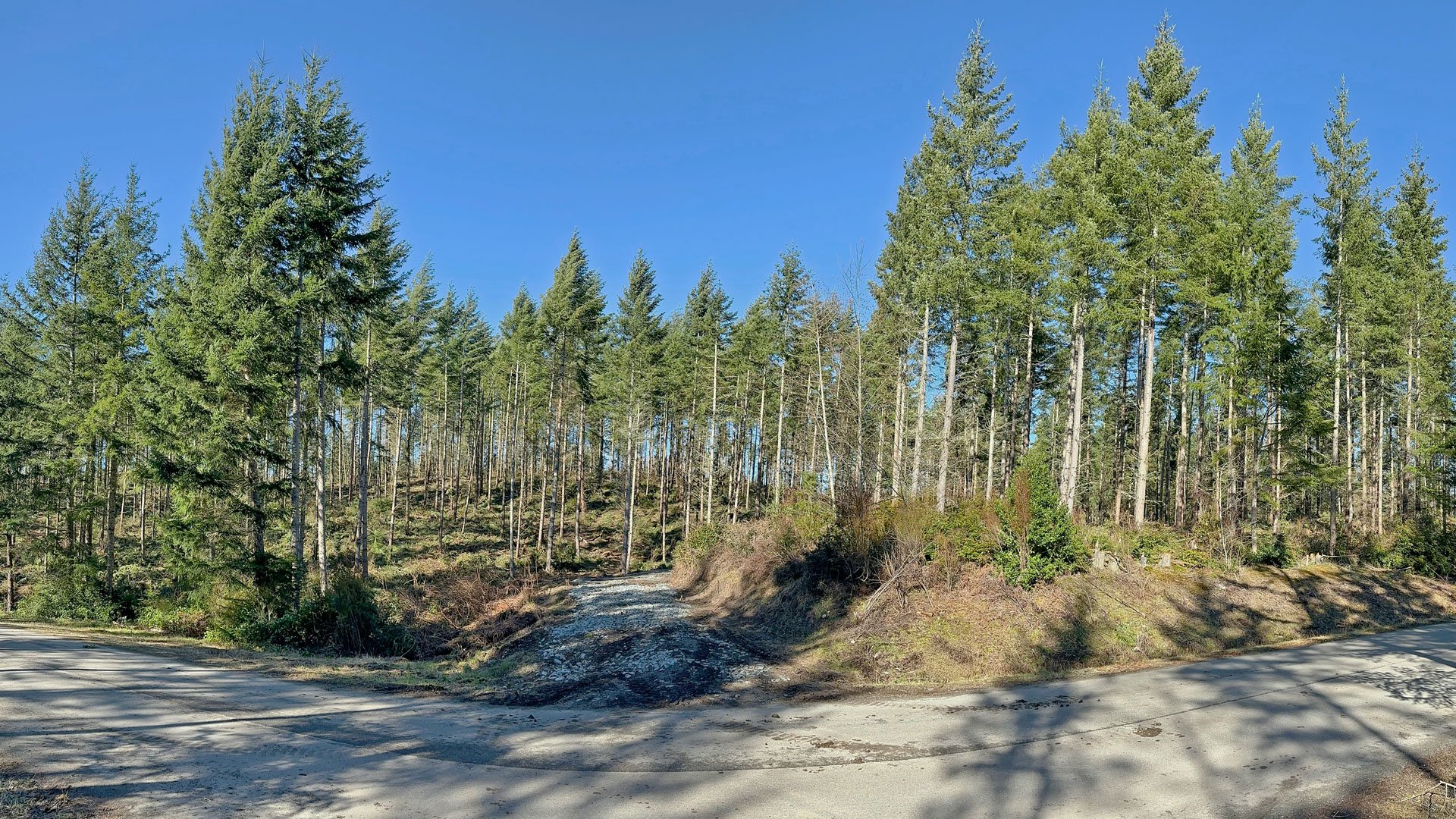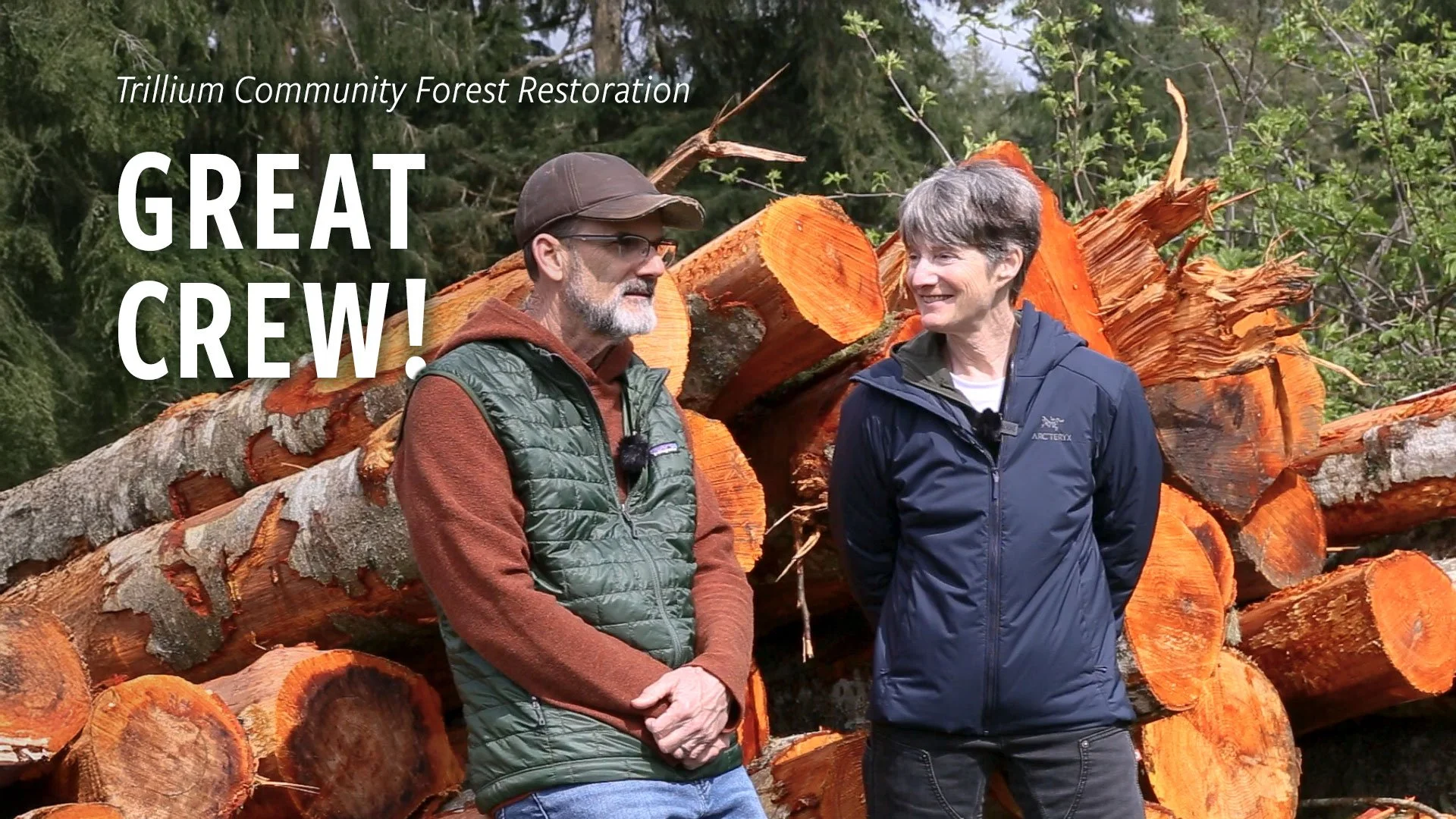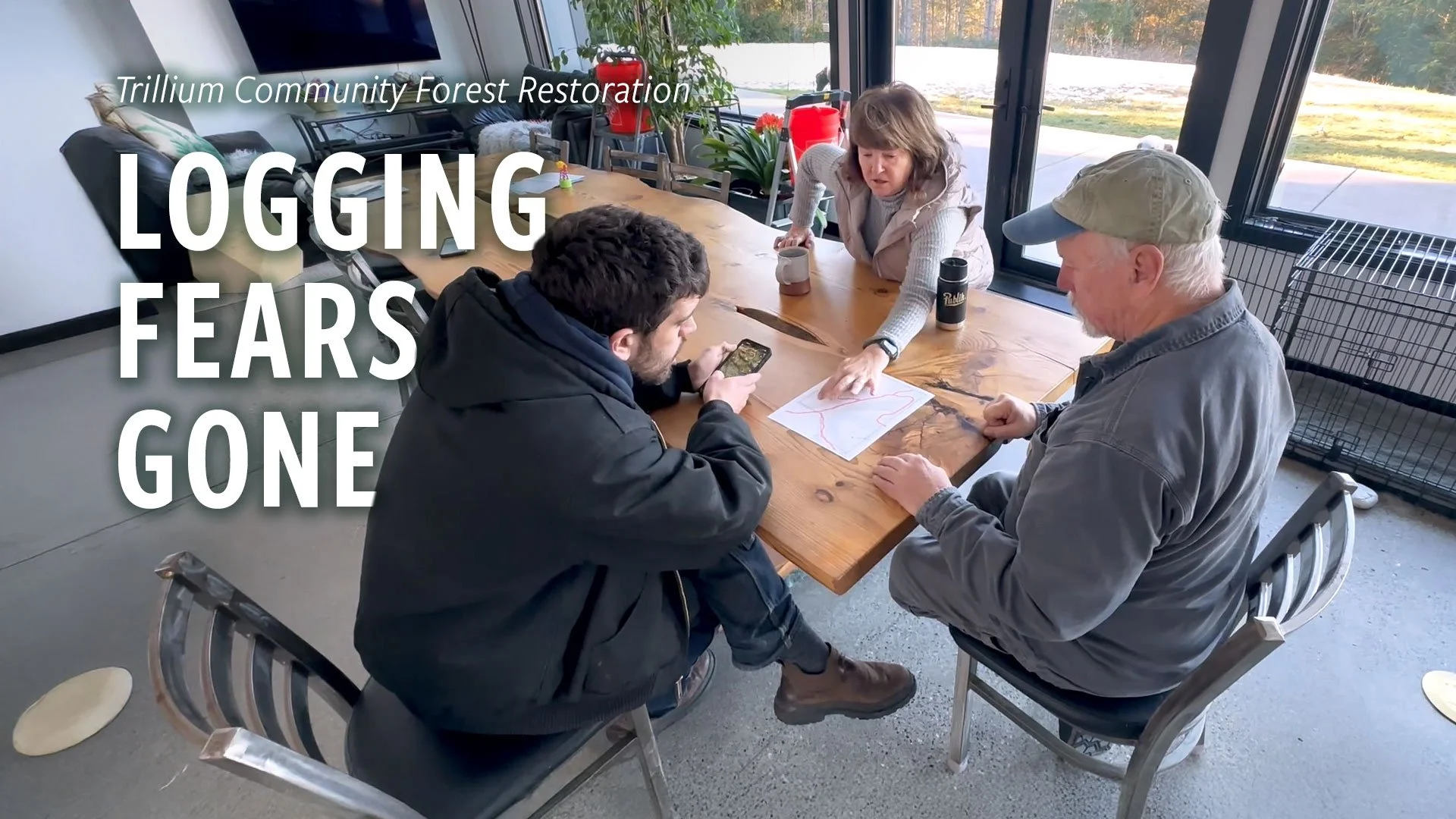
CASE STUDY
The Trillium Community Forest Story
Transforming a Tree Farm into a Thriving Forest:
When the Whidbey Camano Land Trust (WCLT) acquired the 721-acre Trillium property in 2010, they secured the largest remaining undeveloped tract on Whidbey Island — a once-in-a-generation conservation opportunity. The monumental fundraising effort to achieve this is a story in itself, vividly recounted by WCLT staff Mekare and Ashley in an accompanying video segment. They share how, in just six months, a passionate community—from horseback riders and hunters to schoolchildren donating their quarters—rallied to raise $4 million, culminating in a last-minute dash to the bank to secure the land.
Shared Vision for Restoration
Saving Trillium Forest
But what WCLT inherited was not a natural forest; it was a tree farm: dense, homogeneous stands of Douglas-fir planted for timber production, lacking the rich species diversity, multi-layered canopy, and soil health of native forests. Jessica Larson, WCLT's Stewardship Director, elaborates on this initial condition in a video insight, explaining, "Trillium's forest was almost entirely Douglas fir...we had 600 trees per acre in that 400-acre densely planted area, which is far more trees than we wanted. We were really already noticing a lot of issues related to that density in terms of overcrowding, a complete lack of understory...stress in those trees...they were struggling."
Hear from Whidbey Camano Land Trust staff, Mekare and Ashley, as they recount the inspiring community effort to acquire Trillium Community Forest.
Forest In Crisis
Decades of neglect had left the land vulnerable, with overcrowded trees competing for limited resources, increasing susceptibility to disease, drought stress, and wildfire. Securing the property was only the first step. Turning a plantation into a resilient, biodiverse forest would require active, expert intervention.
WCLT carefully evaluated several logging companies before selecting Janicki Logging Co. (JLC) as their partner in 2012. Jessica Larson further details this selection process, noting, "We started our forest management plan in that first year...we knew right away we needed to find the right company that had the same ecological objectives in mind and were able to work with us...Janicki Logging was that perfect partner for us. We actually met them during our management planning process."
Jessica Larson, Stewardship Director at Whidbey Camano Land Trust, describes the ecological challenges and overstocked conditions of Trillium Community Forest before restoration efforts began.
The Ideal Logging Partner
Whidbey Camano Land Trust's Jessica Larson discusses the selection process and finding a partner with shared ecological objectives.
JLC’s proven experience with ecologically sensitive forest management, collaborative planning, and commitment to stewardship made them the ideal fit for Trillium’s ambitious restoration goals.
“…We needed a partner to help us reach those objectives of being able to thin the forest and improve the health, and Janicki had the equipment and the tools to make that a possibility.”
At the time of acquisition, much of Trillium resembled countless neglected tree farms across Washington state. Janet Hall, a WCLT Board Member and volunteer with a background in forest management, recalls the conditions and JLC's understanding: "It was a dark, almost they called a dark forest; I called a sterile forest, there's just nothing happening in there, the trees are not happy because they're so close together. David Janicki and his company got what we wanted to do...this is our, I think, eighth year that we've been thinning...and it really looks good."
Understanding the Challenge
Sterile Forest
WCLT Board Member Janet Hall shares her perspective on the "dark, sterile forest" conditions at Trillium and how Janicki Logging Co. understood the vision for restoration.
This pattern reflects a broader crisis — millions of acres of under-managed U.S. Forest Service lands within Washington alone face similar vulnerabilities, with even greater expanses across the Pacific Northwest and western states. Trillium offered an opportunity to demonstrate how active stewardship could reverse these trends and set a new standard for restoration.
Without intervention, natural succession might eventually diversify the landscape — but it would take centuries, and in the meantime, the site would remain vulnerable to wildfire, pest outbreaks, and ecological collapse.
“They called it a dark forest; I called it a sterile forest. There was just nothing happening in there; the trees were not happy because they’re so close together. David Janicki and his company got what we wanted to do.”
A New Model for Restoration
Rather than "letting nature take its course" and risking catastrophic outcomes, WCLT and JLC embarked on an active management strategy designed to mimic and accelerate natural forest processes. David Janicki, in an insightful video explanation, details part of this approach: "We're here at the Trillium Community Forest and behind me is an area that we haven't treated yet. It's a good example of these habitat gaps or mini-disturbances that we're introducing onto this stand. It's a way to mimic nature and create areas that we can replant to get some other trees besides Douglas fir. The areas that we target for these habitat gaps vary, but the one behind me is actually nature is already doing it itself. It is a diseased area...laminated root rot and it's spreading...so by creating a little gap...stacking the brush, then we're going to replant...to accelerate the multi-story canopy and it also mimics a natural forest rather than an even-aged commercial tree farm."
Mimicking Nature
Over a 12-year period, JLC conducted a series of carefully planned thinning entries, a strategy further detailed by Jessica Larson: "Since we had close to 600 trees per acre, we knew we were going to have to come back multiple times...We were planning two entries into each of our forest stands. One entry we started in 2012, and we got it down to 300-ish trees per acre...Then we waited 10 years...so we gave the babies time to grow some roots, to get strong in the ground. And then we started this next round of thinning back in 2024...and then at that point, we will be pretty much done with the primary restoration thinning on the site."
David Janicki of Janicki Logging Co. explains the strategy of creating habitat gaps and mimicking natural disturbances to restore Trillium Community Forest and combat issues like root rot.
WCLT’s 12-Year Plan
Restoring a forest takes time and a careful plan. WCLT's Jessica Larson outlines the long-term, multi-entry thinning strategy employed at Trillium Community Forest.
2012 — Initial Thinning: Opened up the first corridors and reduced overcrowding.
2016 & 2018 — Second Entry: Expanded on initial work, targeting disease pockets and promoting diversity.
2024 — Final Major Entry: Completed thinning in key areas to set the stage for long-term succession.
Rather than clear-cutting, the team focused on "variable density thinning," preserving dominant healthy trees, removing stressed or diseased individuals, and leaving biological legacies like snags for wildlife habitat. In some areas, they created intentional "mini clear-cuts" — small canopy openings where habitat trees were deliberately left standing. These gaps accelerated regeneration by allowing more sunlight to reach the forest floor and promoting a patchwork of age classes, which enhances structural diversity and wildlife habitat. JLC's careful operational methods, such as using a "slashmat" to minimize soil compression, are also key to this ecologically sensitive approach, as David Janicki explains during a discussion with landowners Peter and Lynnette.
Soil First Logging
David Janicki explains the use of slashmats to protect soil health during thinning operations at Trillium Community Forest.
“With thinning it’s not just about the trees that are left but, also not damaging that soil is really important.”
Signs of Recovery
Today, visitors and residents alike report seeing profound changes at Trillium. Sunlight now filters through the rejuvenated canopy. Native understory plants — salal, ferns, huckleberries, young cedars, and Sitka spruce — have reclaimed once-barren forest floors.
Drag the slider left and right to see before and after
Birdsong echoes through the trees, and sightings of deer and small mammals weaving through the new habitat have become common.
The speed and extent of this recovery are remarkable. David Janicki highlights these changes in a post-treatment video walkthrough: "Previously, before we did this second entry thinning, there was virtually zero understory...By opening up the forest by removing those dead and dying trees, more sunlight can now hit the forest floor. "
Forest Reborn
“As you can see, within less than a year, we have all sorts of different plants which attract little bugs, which attract birds...This increases the biodiversity not only on the plant side but on the animal side, which is one of the main goals.”
David Janicki of Janicki Logging Co. showcases the increased biodiversity and understory growth shortly after ecological thinning.
Encouraged by the dramatic improvements at Trillium, neighboring landowners — some of whom own tracts formerly part of the same historical property — hired JLC to help restore their own forests. Peter and Lynnette, adjacent landowners, share their experience of seeing the Trillium work and its impact on their decision: "I was really impressed by it because it was solving a lot of the problems that we'd already seen on our property which is dark dense and...really not really accommodating to walk through."
Neighbors Amazed!
Hear from Peter and Lynnette, neighbors to Trillium Community Forest, about how observing the restoration work and rapid forest recovery on the Land Trust property inspired them.
“The forest here bounce back so fast…within a year you don’t see the impact of the machinery. What you do see is the impact on the forest which is much much more open.”
Restoration work on these adjacent private lands added nearly 200 more acres to the actively managed landscape, expanding the conservation footprint and strengthening habitat connectivity.
Importantly, the restoration work was not only ecologically successful — it was economically sustainable. The value of merchantable timber removed during thinning operations exceeded the cost of the work, including necessary access road improvements. David Janicki touches upon this economic model: "This thinning description...it creates more volume and higher quality lumber...and we can use that in order to pay for this service. And so we're able to again, slowly, more rapidly turn this tree farm into a working forest."
Restoration Pays?
David Janicki discusses how the value of timber from thinning operations helps fund the restoration work at Trillium Community Forest.
In cases where revenues surpassed expenses, surplus income was returned to property owners, creating a new model for incentivized private conservation.
Restoring Trillium was more than a technical success. It became a story of shared purpose, mutual trust, and people learning to see the forest — and one another — in a new light.
From the outset, WCLT and JLC entered the project with different perspectives but a common goal: to turn a struggling tree farm into a thriving, resilient forest. Trust wasn’t automatic — it was built over years of consistent communication, transparent practices, and a willingness to adapt when needed. Each decision reflected a commitment to long-term ecological health. The quality of this working relationship is evident in the experiences of adjacent landowners. Gary and Sarah Hess, for instance, describe JLC's professionalism and collaborative spirit: "We've really enjoyed working with the Janicki crew...the cutting operator called us...he wanted to make sure he was doing what we had asked...David's been great...he's a busy guy...runs a good crew, a lot of really good equipment."
Trust, Collaboration, and Shared Stewardship
Great Crew!
Adjacent landowners Gary and Sarah Hess share their positive experiences working with the Janicki Logging Co. crew and David Janicki during the restoration of their own forest land.
“I’ve been very impressed in just one year how quickly the forest has bounced back.”
As the project progressed, collaboration expanded. Neighboring landowners who had once been skeptical became partners in restoration. This journey from apprehension to advocacy is powerfully shared by Peter and Lynnette, who initially were "afraid of logging," fearing their property would be "mowed down," but whose perspective completely changed after witnessing JLC's careful work at Trillium and then on their own land. They recount how their realtor even asked, "Do you really want to be loggers?" and their initial thought was, "No I have no idea what that's about." But seeing the positive changes and the careful approach led them to say, "Yes, we want this now."
Logging Fears Gone
Peter and Lynnette, neighbors of Trillium, share their journey from being "afraid of logging" to becoming advocates for ecological thinning after seeing Janicki Logging Co.'s work.
“Actually, we were afraid of logging... our concept was that it would just be completely, you know, basically mowed down and then replanted.”
WCLT volunteers who were initially wary of logging machinery came to see it not as a threat, but as a tool in service of conservation. (Some even operated the equipment themselves.) This process of education and changing perceptions was a deliberate effort, as Jessica Larson explains: "We knew that it was going to be something that the public in particular had concerns about...a lot of people want to freeze a property in time...So we knew going in that we were going to have to explain to people why we're doing that restoration work. That short-term disturbance can lead to long-term gains...We did a pretty extensive communications campaign beforehand...and then also a lot of tours."
Changing Minds
WCLT's Jessica Larson discusses the importance of public outreach, tours, and how they helped change perceptions about the restoration work at Trillium.
“...We had folks that called and complained and said ‘It’s destructive’...and then they’d come out on a tour and be like, ‘Oh, I get it...it’s really helping the forest so much that it’s worthwhile.’ ”
Visiting Trillium Today
Today, Trillium welcomes visitors year-round as a living classroom for restoration — and a peaceful place to walk among a recovering forest. Visitors can explore over eight miles of maintained trails, frequented by hikers, runners, mountain bikers, and horseback riders. It's one of the few places in the region where you can walk through an actively recovering forest and see firsthand how thoughtful stewardship changes a landscape.
To learn more about the Trillium Community Forest, visit Whatcom Camano Land Trust’s website at https://www.wclt.org/projects/trillium-community-forest/ where you can explore their story map, download the most current trail map, and find driving directions to each of the three trailheads.
The success at Trillium offers a powerful lesson: conservation isn’t passive. It takes hands-on care, thoughtful planning, and the courage to adapt. With science-driven strategies, committed partnerships, and adaptive stewardship, working forests can become thriving ecosystems.
For those interested in learning more about the restoration process, WCLT and JLC have periodically hosted special tours for conservation groups, municipal land managers, and forest landowners. Future tour opportunities may be available upon inquiry.
Lessons for Other Landowners
Related Stories From Our Resources & Insights Hub
Go deeper into the science and strategy behind our work.























